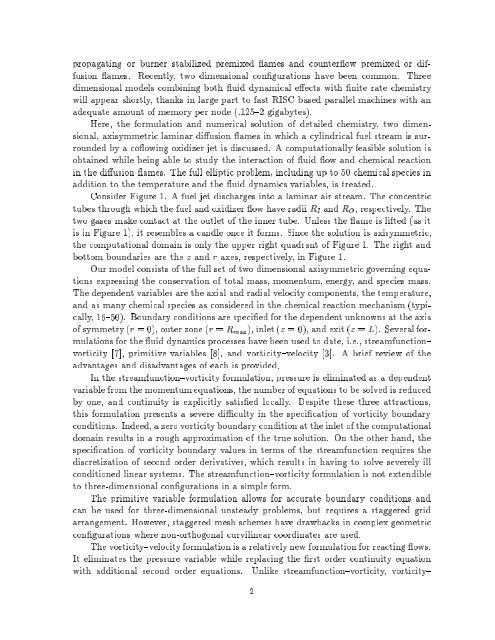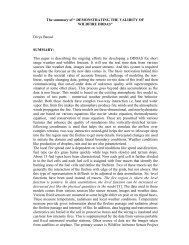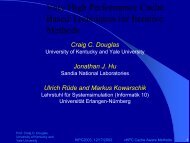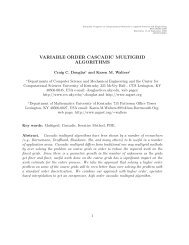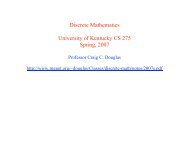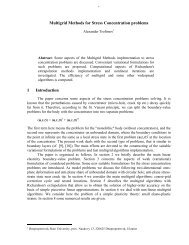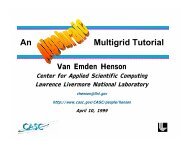numerical simulation of laminar diffusion flames problem ... - MGNet
numerical simulation of laminar diffusion flames problem ... - MGNet
numerical simulation of laminar diffusion flames problem ... - MGNet
You also want an ePaper? Increase the reach of your titles
YUMPU automatically turns print PDFs into web optimized ePapers that Google loves.
propagating or burner stabilized premixed ames and counterow premixed or <strong>diffusion</strong>ames. Recently, two dimensional congurations have been common. Threedimensional models combining both uid dynamical eects with nite rate chemistrywill appear shortly, thanks in large part to fast RISC based parallel machines with anadequate amount <strong>of</strong> memory per node (.125{2 gigabytes).Here, the formulation and <strong>numerical</strong> solution <strong>of</strong> detailed chemistry, two dimensional,axisymmetric <strong>laminar</strong> diusion ames in which a cylindrical fuel stream is surroundedby a coowing oxidizer jet is discussed. A computationally feasible solution isobtained while being able to study the interaction <strong>of</strong> uid ow and chemical reactionin the diusion ames. The full elliptic <strong>problem</strong>, including up to 50 chemical species inaddition to the temperature and the uid dynamics variables, is treated.Consider Figure 1. A fuel jet discharges into a <strong>laminar</strong> air stream. The concentrictubes through which the fuel and oxidizer ow have radii R I and R O , respectively. Thetwo gases make contact at the outlet <strong>of</strong> the inner tube. Unless the ame is lifted (as itis in Figure 1), it resembles a candle once it forms. Since the solution is axisymmetric,the computational domain is only the upper right quadrant <strong>of</strong> Figure 1. The right andbottom boundaries are the z and r axes, respectively, in Figure 1.Our model consists <strong>of</strong> the full set <strong>of</strong> two dimensional axisymmetricgoverning equationsexpressing the conservation <strong>of</strong> total mass, momentum, energy, and species mass.The dependent variables are the axial and radial velocity components, the temperature,and as many chemical species as considered in the chemical reaction mechanism (typically,16{50). Boundary conditions are specied for the dependent unknowns at the axis<strong>of</strong> symmetry (r = 0), outer zone (r = R max ), inlet (z = 0), and exit (z = L). Several formulationsfor the uid dynamics processes have been used to date, i.e., streamfunction{vorticity [7], primitive variables [8], and vorticity{velocity [3]. A brief review <strong>of</strong> theadvantages and disadvantages <strong>of</strong> each isprovided.In the streamfunction{vorticity formulation, pressure is eliminated as a dependentvariable from the momentum equations, the number <strong>of</strong> equations to be solved is reducedby one, and continuity is explicitly satised locally. Despite these three attractions,this formulation presents a severe diculty in the specication <strong>of</strong> vorticity boundaryconditions. Indeed, a zero vorticity boundary condition at the inlet <strong>of</strong> the computationaldomain results in a rough approximation <strong>of</strong> the true solution. On the other hand, thespecication <strong>of</strong> vorticity boundary values in terms <strong>of</strong> the streamfunction requires thediscretization <strong>of</strong> second order derivatives, which results in having to solve severely illconditioned linear systems. The streamfunction{vorticity formulation is not extendibleto three-dimensional congurations in a simple form.The primitive variable formulation allows for accurate boundary conditions andcan be used for three-dimensional unsteady <strong>problem</strong>s, but requires a staggered gridarrangement. However, staggered mesh schemes have drawbacks in complex geometriccongurations where non-orthogonal curvilinear coordinates are used.The vorticity{velocity formulation is a relatively new formulation for reacting ows.It eliminates the pressure variable while replacing the rst order continuity equationwith additional second order equations. Unlike streamfunction{vorticity, vorticity{2


